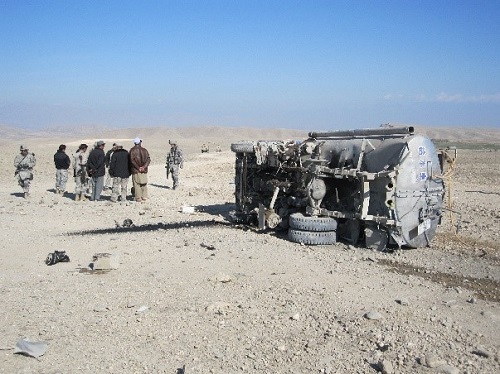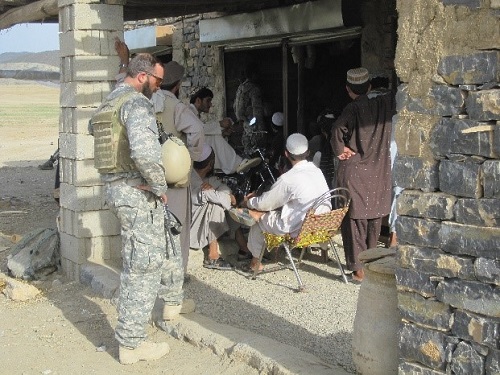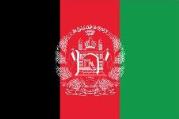Realpolitik in Afghanistan:
Pragmatic Influence Required
by RJ Hampsey, February 2018
The defeat of the ISIS self-declared Caliphate in
Iraq and the Levant has caused many strategic pundits to refocus on the
“ungoverned” areas of Afghanistan and a resurgent Taliban. With the refocus comes much speculation on how to win the hearts
and minds of the “Afghans.” One hopes this time around is the last, and
perhaps the U.S. will realize that “winning the hearts and minds” may not be necessary
to earn cooperation to achieve a mutually beneficial future between the
West and Afghanistan.
What are the interests of the United States and NATO in Afghanistan? Let’s hypothesize that it’s to reduce “ungoverned” spaces to
prevent terrorist organizations from operating in those spaces, then
threatening attacks in the West.
What are the interests of the rural population (the sea the Taliban
swims in)? Let’s hypothesize that this population wants to provide the
basic necessities to their family and clan in a safe self-governed
environment. Sounds congruent,
but reality is more difficult.

"A Message From the People"
Photo by Mr. S. McKenna, CAAT
A Tale. One of my first experiences as an IO advisor in Afghanistan
included an embed with a unit training provincial police in Pashtun
populated eastern Afghanistan. Understanding the Pashtun culture is a
lifelong endeavor, but the event shown in the picture above captures it in a
nutshell. The area shown
looks like a harsh desert but in reality it is less than a quarter mile
away from an extensive plot of tiered lush green fields. A U.S. outpost was also nearby. The location of the outpost was along the escape route used by
many of the Al-Qaeda and Taliban leaders early in the war, plotting a
security post there limited the use of that route while forward
positioning forces to disrupt adversary movements. The truck in the
picture is a human waste vehicle from the outpost. The truck had been spreading the human waste on a barren field
that had an underground water source to nourish those fields. According to the district police chief the local elders asked the
camp leaders to stop using that area as a flush point, but the act did
not stop. When it didn’t
stop, a small IED was placed on the path of the spreader. A tire was blown off, truck partially flipped, and driver
essentially unhurt. The
size of the IED was not designed to kill, just send a message. We were 8
years into the Afghan conflict, and did not understand (or perhaps did)
why disposing the waste in that specific area was a bad thing. The Afghans asked for it to stop, and when it did not, they
defended their resource.
These same Afghans, prevented that outpost from being rocketed or
mortared for years and until the truck incident there was little kinetic
action in the area.
So what? On the surface spreading that human waste
in a barren field seemed logical, and the request for it to stop
illogical. So it continued
until the event forced us to pay attention to the interests of the local
population. Let’s zoom this
to a strategic view. 17
years into the Afghan Conflict and we have not defeated the Taliban to
the point of surrender.
Total surrender is not going to happen; but why?
At the risk of over simplifying. We have the most efficient killing force ever seen on the face of
this earth, yet the Taliban is again gaining strength. It might be worth remembering that the Taliban is not Al-Qaeda,
or the Islamic State of Iraq and the Levant (ISIL). Yes, the Taliban
hosted Al-Qaeda even after 9-11 because the leader of the Taliban,
Mohammed Mullah Omar (MMO) AKA the Leader of the faithful, felt bound by
Pashtun idea of protecting guests invited into your home. Don’t get me wrong, the Taliban too is a fundamentalist Wahabbi
based movement that committed atrocities inside the borders of
Afghanistan, but they never attacked the United States soil. Quick review, MMO and the Taliban also were part of the force
that fought and defeated the USSR (with our help) protecting the Afghan
people from a foreign governing structure being forced upon them. The Taliban emerged as a liberating force after Soviet
withdrawal. Heroes of the
Afghans. Every Afghan I
ever asked in the eastern provinces had family members, or, themselves
were considered Taliban.
The US and NATO are determined to prevent
Afghanistan from ever again becoming a free-play zone for terrorists. Rightfully so, many areas in Afghanistan and Pakistan’s Federally
Administered Tribal Areas (FATA) housed and continue to house training
areas for some of the world’s worst terrorist organizations. These organizations are savvy enough to know if they provide
arms, funds, and motivation to the Taliban, they will continue to
disrupt the efforts of the Afghan security forces creating the
opportunity to train their terrorists in other parts of the nation.
The Taliban is being used to
some extent.
We need to understand this framework if we are going to discuss
how we are going to influence the Afghans to partner with us to achieve
not only our objective but theirs’ as well. Below are two simple theories that might help us re-gain a
partnership with the majority of Afghans. These two ideas focus on knowledge of the Afghan culture and
audience; their goals, concerns, and reality. Unlike some other articles, I will not be prescriptive in terms
of resources, without an agreement on the end-game the forces don’t
matter.
“We are here to help the Vietnamese because inside every
gook there is
an American trying to burst out.”
Poge Colonel, from the film “Full Metal Jacket” (1987).
Common interests. The ungoverned spaces are not unpopulated. Where there are
people, there are good guys and/or bad guys trying to gain support of
the people. One side even
takes quarter and resources from the population leveraging the nature of
the Afghan hospitality and Islamic commonality. This side is often despairingly called “foreigners” or “the
Arabs” by the locals. These foreigners disrupt the locals’ ability to
take care of their own, preventing them from achieving their interests. Given this circumstance, you don’t even have to train the locals
nor arm the population.
Initially if they need help to reject the foreigners then help with the
goal of the locals are able to take care of their family.
Prove you share the same
interest regarding the foreigners. Our gain, protecting the village protects the world from the
foreigners; terrorists.
“All politics is local” attributed widely
to Former Speaker of the House Tip O’Neill.

"The Afghan Way of Governing: An Impromptu Shura with Security Forces"
Photo by SSG D. Smith, US Army
There is a traditional power
structure throughout Eastern and Southern Afghanistan, and it doesn’t
always look like a western society’s structure. This Shura through Loya Jirga structure has served Afghanistan
for years. The Taliban used this structure to spread their regime
because they were weened in that system. In that system tribes, clans (foundation of districts) govern
locally, settle disputes, protect the populations and negotiate with
neighbors. If outside
resources were needed they were directly requested from the monarchy, or
federal power structure.
The province wasn’t even a consideration. Therefore, even 17 years later, there are many Afghan leaders
that are associated with the Taliban, as are their brothers, cousins,
and clan members. Is the
Taliban our enemy, or do they share the interests of the US and NATO to
reject “foreigners” that threaten the population’s ability to provide
for their family. If we
continue to reject the Taliban, do we reject a significant portion of
the population that just might want the same thing we do, foreigners out
of Afghanistan. We have to
forge a treaty that includes representatives of the Taliban, alongside
the sitting federal government, starting with expelling foreign
terrorists like Al Qaeda, the Islamic State, and even the Tehrik e
Talibi from Pakistan out of Afghanistan. The influence operation convinces the Afghans that we share their
goal to get foreign military interference out, to include ourselves.
Our guarantee must include
providing Afghans with the ability to target and eliminate “foreigners”
seeking to exploit rural Afghanistan.
Conclusion. Practical strategic objectives, learned after 17 years of
walking among the Afghans, should not be wasted in the political power
centers in Washington DC and Brussels. The military forces we have developed over the past
decade and one half, to
include the 'Train, Advise, and Assist' brigades, are all results of the evolution experienced
from this war and are very capable. But no force will “win” support without a common endgame among
partners. Let’s start with
getting the foreigners out of Afghanistan, using the Afghans; even the
Taliban to help. Our common goal
is the security of the family, clan, and village that will ensure
terrorists will no longer freely operate in Afghanistan. I acknowledge this isn’t groundbreaking, just some reapplication
of tactics, techniques, and procedures (TTPs) we used in Unconventional
Warfare (UW) and Foreign Internal Defense (FID) pre-9-11.
About the Author: RJ Hampsey joined the Counterinsurgency (COIN) Advise and Assist
Team (CAAT) in November 2009 and was assigned to advise and assist the
officers, NCOs, and Soldiers executing information operations, PSYOP,
and Civil Affairs in support of Regional Command East. In total he spent 36 Months as a member of the CAAT in RC-E and
HQ-ISAF; and the Military Information Support Task Force. (MISTF).
|




